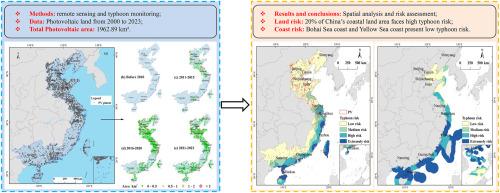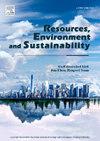中国沿海地区光伏电站对台风灾害的时空暴露及其可持续发展
IF 7.8
Q1 ENVIRONMENTAL SCIENCES
引用次数: 0
摘要
气候适应性太阳能规划直接有助于实现联合国可持续发展目标7和13。中国在全球光伏扩张方面处于领先地位,而沿海地区气候风险不断升级,这两者并存,凸显了将光伏布局与风险缓解相结合的重要性。利用陆地卫星影像分析了中国沿海地区PV分布的时空变化,并评估了台风灾害对PV的影响。重点研究结果表明,到2023年底,沿海地区光伏总面积约为1962.89 km2。值得注意的是,长江以北省份的光伏面积是长江以南省份的两倍多。2015年后开始快速扩张,光伏面积在2020年至2023年间增长了一倍以上。从灾害风险的角度来看,中国约20%的沿海陆地面积面临台风高风险,16%的现有光伏面积位于高风险地区。东海和南海是极端风险区最集中的地区。令人鼓舞的是,最近82.15%的光伏扩张发生在低至中等风险地区,这表明目前的布局策略已经考虑到了台风的威胁。展望未来,渤海沿岸、黄海沿岸和南沙群岛附近沿海风险相对较低,是未来海上光伏项目的首选。相比之下,东海和南海沿岸仍然是高风险地区,需要谨慎规划海上光伏发展。本文章由计算机程序翻译,如有差异,请以英文原文为准。

Spatio-temporal exposure of photovoltaic farms to typhoon disasters for sustainable development in China's Coastal Regions
The climate-adaptive solar energy planning contributes directly to the United Nations Sustainable Development Goals 7 and 13. The juxtaposition of China's leadership in global PV expansion and the escalating climate risks in its coastal regions underscores the importance of aligning PV layout with risk mitigation. This study utilizes Landsat imagery to analyze the spatiotemporal changes of PV distribution in China's coastal regions, and assesses the effect of typhoon disasters to PV. Key findings reveal that by the end of 2023, the total PV area in coastal regions reached approximately 1962.89 km2. Notably, provinces north of the Yangtze River hosted more than twice the PV area of those to the south. Rapid expansion began post-2015, with PV area more than doubling between 2020 and 2023. From a disaster risk perspective, about 20 % of China's coastal land area faces high typhoon risk, with 16 % of existing PV area located in high-risk regions. The East China Sea and South China Sea coasts exhibit the highest concentration of extreme-risk regions. Encouragingly, 82.15 % of recent PV expansion occurred in low-to-medium-risk regions, indicating that current layout strategies already account for typhoon threats. Looking ahead, the Bohai Sea coast, Yellow Sea coast, and coasts near the Nansha Islands present relatively low risk, making them preferable for future offshore PV projects. In contrast, the East and South China Sea coasts remain high-risk regions, necessitating cautious planning for offshore PV development.
求助全文
通过发布文献求助,成功后即可免费获取论文全文。
去求助
来源期刊

Resources Environment and Sustainability
Environmental Science-Environmental Science (miscellaneous)
CiteScore
15.10
自引率
0.00%
发文量
41
审稿时长
33 days
 求助内容:
求助内容: 应助结果提醒方式:
应助结果提醒方式:


